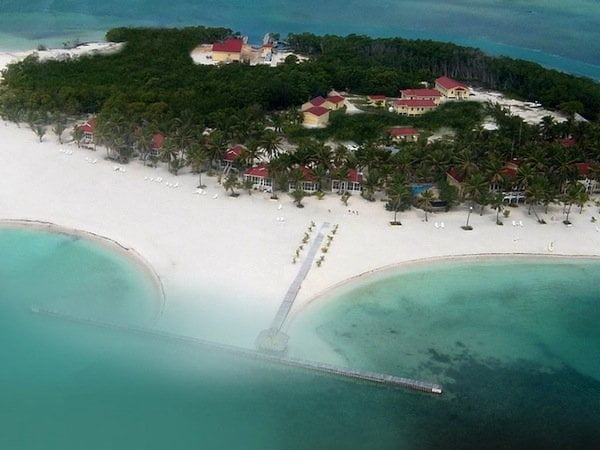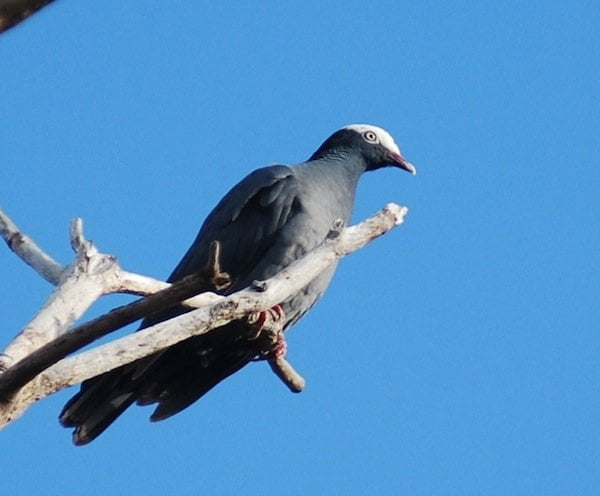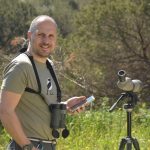Even professional birders need a break, right? Whilst most people correctly point out that making a living from one’s hobby is the dream job, it sure feels good to do some lazy birding once in a while. And Turneffe Island off Belize is the perfect destination to spot a Yucatan Vireo from behind the crystal-encrusted rim of a giant margarita. Turneffe Island is situated in the Turneffe atoll approximately 30 miles off the mainland of Belize. Renowned for its world-class diving and fishing, the atoll also offers a totally different perspective on birding in Belize. Not so much for any particularly rare or endemic species but for a marvel of the avian world – the breeding colonies of Red-footed Boobies and Magnificent Frigatebirds that breed here from December to June every year.
 Turneffe Island off the coast of Belize
Turneffe Island off the coast of Belize
The 12-acre Turneffe Island is surrounded by mangroves, white sandy shores and has a small hammock of forest that is great for migrating songbirds and a few resident specialities. Its amazing just how many birds take refuge on a small island like this. Dainty Cinnamon Hummingbirds hover about the flowering plants, the near-endemic Yucatan Vireos can be found in any patch of vegetation, White-crowned Pigeons take shelter in the mangroves, a variety of wading birds and shorebirds frequent the sandy shores and Golden-fronted Woodpeckers and Mangrove Warblers are abundant. And if you happen to be on the island in spring or fall you will be treated to excellent views of American Redstarts, Black-throated Green Warblers, Yellow Warblers, Hooded Orioles, Palm Warblers, Summer Tanagers, Black-and-White Warblers, Yellow-bellied Sapsuckers and many more. In fact, at the height of the migration season and when conditions dictate, the island becomes an excellent migrant fall-out spot.
To experience the breeding colony of boobies and frigatebirds, the only way is to head out to Half Moon Caye by boat, with one or two stops along the way. And stop you must. En route to Half Moon Caye lies one of the world’s legendary dive sites, a place so unique and so magical that a brief diversion from birding is called for. This place is The Blue Hole, a vertical submarine cave complete with stalactites and other cave-like attributes. I could have sworn there were bats too but I had been drinking the night before so don’t take my word for it.
The Red-footed Booby is in the gannet family Sulidae and is the smallest member of this elite crew of dive-bombers. Boobies and gannets have specially adapted facial air-sacs that cushion the impact when diving from great heights to capture fish. Like chocolate, Red-footed Boobies come in 2 color varieties, a light phase and a dark phase. Although not as tasty as chocolate, early sailors certainly took a liking to booby soup. For the early sailors, catching boobies was the equivalent of me subduing my 7-year old at scrabble. Ok not the 7-year old but the 3-year old. It was easy. The word “booby” literally means a “dunce” or a “clown” and refers to the not-so-clever habit they have of landing on sailing vessels. Literally right into the cooking pot. They could at least have had the courtesy to pluck themselves when they landed, instead of providing more work for those tired sailors. Proof that even in those days there was no such thing as an easy meal.
The breeding Red-footed Boobies share Half Moon Caye with Magnificent Frigatebirds, the pirates of the Caribbean. Also known as “Man O’Wars”, the frigatebirds are feared for their habit of pirating well-earned meals from other unfortunate seabirds. These spectacular birds can be seen in their prime on Half Moon Caye during the breeding season, when the males publicly beat their beaks on their inflated bright red gular air sacs. I’m surprised the females put up with this vulgar display. It certainly would not be tolerated in our society. But the display seems to be quite a turn-on for the females. And seeing this display has to rank as one of the marvels of the avian world, right up there with displaying birds of paradise and dancing bowerbirds.
So next time you think about planning a trip to Belize, don’t ignore the offshore islands. But don’t stay too long lest, like Jimmy Buffett, you waste away in Margaritaville.














Talk about a gorgeous place to watch birds!
Yes Pat – armchair birding at its finest!
Very intersting post. Belize is a birding paradise indeed! At our nature reserve, we have spotted over 365 species of birds.
You can check out the pdf file here http://www.chaacreek.com/images/bird_watching/birds%20of%20chaa%20creek%202009.pdf
I spent 6 weeks diving on Turneffe. I don’t remember much about the birds, but it was a great place.
It is really nice to feature Belize as a birding paradise. I have done bird watching at home and have had some nice experiences.! I miss birding in Belize. I guess i need much more adventures in my own country Belize!